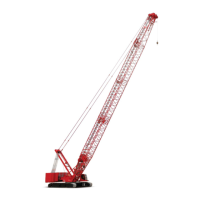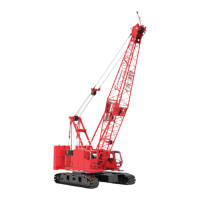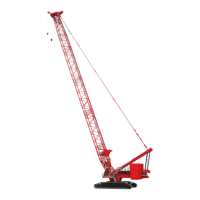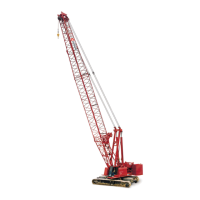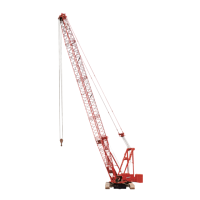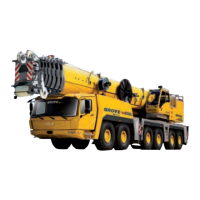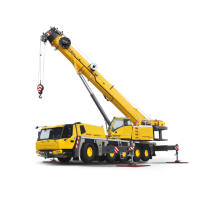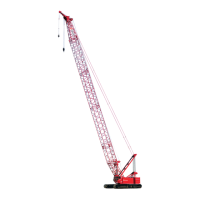Do you have a question about the Manitowoc MLC165-1 and is the answer not in the manual?
Covers crane/attachment identification, orientation, component location, weights, dimensions, and conversions.
Details on identifying the crane, finding a dealer, and handling ownership changes or technical issues.
Visual guide identifying major crane components and their locations on the machine.
Information on crane weights, outline dimensions, and English to metric conversions for specifications.
Covers safety messages, signals, symbols, and general safe operating practices for crane use.
Details on maintaining, ordering safety signs, and identifying common symbols used on the crane.
Guidelines for safe access to crane components and procedures for getting on and off the crane.
Importance of storing and using correct operator manuals and capacity charts for safe operation.
Core practices for safe operation, manual reading, operator qualifications, and conduct.
Critical procedures for handling loads, including size, attachment, lifting, and moving operations.
Procedures and safety considerations for lifting applications using multiple load lines.
Importance of continuous communication and standard hand signals for crane operation.
Overview of safety devices and operational aids, including their categories and maintenance requirements.
Precautions for operating near power lines, including electrocution hazards and emergency contact procedures.
Emergency actions to take in case of contact with an energized power source.
Procedures for safe refueling, fire extinguisher use, and accident reporting.
General and specific practices for performing maintenance safely to prevent injury.
Emphasizes PPE, avoiding hazards like pinch points, and safe practices for electrical and welding tasks.
Guidelines for proper disposal of waste materials and fluids to protect the environment.
Critical safety instructions for disassembling boom sections to prevent collapse hazards.
Safe practices for pin removal, blocking, and general disassembly precautions for booms.
Regulations and guidelines for using cranes to lift personnel platforms safely.
Safety considerations for operating cranes on barges or pedestals, including overload and fastening warnings.
Factors affecting capacity and safe operation on barges, including list definitions and specific capacity charts.
Detailed description of controls and indicators within the operator cab, including consoles and pedals.
Operation of setup controls, including remote and carbody controls, and entering setup mode.
Explanation of boom angle indicator, RCL/RCI warning light, and upperworks bubble level for monitoring crane status.
Identification of crane operating limits and fault conditions, including specific limits like Boom Max Up and Rated Capacity.
Overview of the main display screen showing operating conditions, faults, and diagnostic information.
Interpretation of engine warning lights and fault codes, including Tier 4 engine specifics and SCR regeneration.
Safety procedures for operating in wind and requirements for crawler blocking for stability.
Step-by-step instructions for starting the crane engine and performing pre-operation checks.
Detailed procedure for operating the boom hoist, including raising, lowering, and stopping the boom.
Procedures for swinging the upperworks, including smooth acceleration and stopping.
Instructions for operating load drums in full power mode for lifting and lowering loads.
Procedures for operating load drums in free fall mode for controlled lowering.
Procedures for operating the crane in clamshell mode, including preparation and adjustments.
Comprehensive instructions for traveling the crane, including speed selection and turning maneuvers.
Steps for safely shutting down the crane and securing it when unattended.
Guidelines for operating in cold weather, including crane limitations, hazards, and component protection.
Importance of heaters for engine, oil, coolant, and batteries in cold weather.
Procedures for turning on and off the 240 VAC electric system and its components.
Details on the optional heater package and its components for cold weather preheating.
Illustrations and explanations of standard hand signals for crane operation communication.
Identification of symbols used on control consoles for various functions.
General safety guidelines to prevent accidents during crane assembly and disassembly.
Defines terms like front, rear, left, and right relative to the operator's cab for assembly context.
Key considerations for assembling and disassembling the crane safely and correctly.
Procedures for selecting an assembly area, accessing parts, retaining pins, and managing parts boxes.
Procedures for cleaning hoses, cables, and components, and connecting self-assembly parts.
Identifies self-assembly components and the importance of load sensing pins for safety.
Details on self-assembly controls, including remote control and activating setup mode.
Instructions for removing and storing window covers for both standard and vision cabs.
Procedure for rotating the operator cab from shipping to working position.
Steps for installing the RCL/RCI indicator light and the rotating bed mirror.
Procedure for raising optional handrails on the rotating bed.
Essential checks before assembly/disassembly and procedure for starting the crane engine.
Steps for preparing and raising the mast to its vertical position for assembly.
Illustrates mast angles, working ranges, and associated hazards.
Initial steps for installing crawlers, including cleaning and preparing surfaces.
Detailed steps for lifting and positioning the first crawler assembly onto the carbody.
Final steps for connecting hydraulic lines and installing crawler steps after positioning.
Procedure for installing platform sections on the upperworks on both sides of the crane.
Steps for installing carbody counterweights for cranes with the Series 2 package.
Procedure for attaching counterweight boxes to the counterweight tray.
Steps for lifting and securing the crane counterweight using remote control and pins.
Instructions for installing optional work lights on the crane counterweight.
Procedures for removing the boom butt, raising the wire rope guide, and raising boom stops.
Step-by-step instructions for connecting the boom butt to the crane, including pin and shim management.
Procedure for assembling boom inserts to the boom butt, including pin installation.
Steps for connecting mast links to boom straps, including pin and strap storage.
Instructions for connecting electric cables and hydraulic hoses between the crane and boom butt.
Guidance to finish boom and jib assembly by referring to specific assembly procedures.
Critical steps and checks for safely raising the boom, including pre-raising checks and the raising procedure.
A comprehensive checklist of items to verify before initiating boom raising.
Detailed steps for raising the boom, including using an assist crane and managing straps.
Steps to prepare the crane for disassembly and safely lower the boom.
Initial steps to prepare the crane for the disassembly process.
Detailed procedure for safely lowering the boom onto blocking.
Steps for removing and storing block-up limit components, load lines, work lights, wiring, and hoses.
Steps for connecting mast links to boom straps, including pin and strap storage.
Steps to disconnect the boom butt from the crane and disassemble boom sections.
Detailed steps for removing the boom butt from the crane, including pin and shim management.
Procedures for lowering and storing boom stops and the wire rope guide.
Instructions for lifting the boom butt onto a trailer for transport.
Procedure for removing and storing optional work lights on the counterweight tray.
Steps for removing the crane counterweight using remote controls and lifting equipment.
Procedures for disassembling crane counterweight boxes and the counterweight tray.
Steps for removing carbody counterweights for cranes with the Series 2 package.
Procedure for removing platform sections from the upperworks on both sides of the crane.
Initial steps for removing crawlers, including disconnecting hydraulic lines and guards.
Detailed steps for lifting and positioning the first crawler assembly onto the carbody.
Procedure for removing the second crawler and storing platform sections.
Steps for lowering the mast to transport position, securing handrails, mirrors, RCL/RCI light, and cab.
Steps to lift the crane from the trailer and prepare it for transport.
Information about optional boom ladders and their installation and storage procedures.
General information on rigging booms and jibs, including assist crane requirements and blocked crawlers.
How boom and jib sections are marked for identification and proper handling.
Procedure for assembling boom sections, starting with the shortest insert.
Step-by-step instructions for assembling boom inserts, including lifting and pinning.
Procedure for installing the intermediate suspension strut between boom inserts.
Steps for attaching the boom top and raising the wire rope guide.
Steps for connecting boom straps at the top end of each insert.
Necessity and procedure for removing or installing lower boom point sheave clusters.
Procedure for installing the upper boom point onto the lower boom point.
Instructions for attaching the optional pile driver adapter.
Installing wind/position lights, connecting boom wiring, load lines, and block-up limit components.
Procedures for disassembling boom sections, assuming boom and jib are lowered.
Steps for lowering the boom and jib for disassembly, including pin and cable management.
Procedure for removing the intermediate suspension strut, requiring an assist crane.
Procedure for assembling the #134 jib, including handling jib sections safely.
Safe handling procedures for jib sections, especially when lifting lugs are not present.
Attaching jib pendants to the jib top and strut in matched sets.
Procedure for installing backstay links, spreader, and pendants to the jib strut.
Steps for connecting backstay pendants to boom straps or links based on jib offset.
Procedure for fastening the control cable guide and installing the jib stop assembly.
Installing wind/position lights and connecting jib wiring.
Routing and installing jib load lines and block-up limit components.
Steps for disassembling the #134 jib, including lowering boom/jib and storing jib stop.
Steps for lowering the boom and jib for disassembly, including pin and cable management.
Procedures for wire rope installation, specifications, storage, seizing, and cutting.
Procedures for applying seizings and cutting wire rope correctly.
Steps for anchoring wire rope to the drum and winding it correctly to prevent damage.
Procedure for breaking in new wire rope under light load to seat strands and prevent slackening.
Steps for anchoring wire rope to wedge and button sockets, emphasizing correct methods and parts.
Guidelines for using pad eyes for reeving load blocks and safety precautions.
How to operate the rigging winch and select its mode via the main display.
Procedures for using the rigging winch to assist in reeving load lines and managing rigging line tension.
Procedures for routing load lines, identifying load blocks, and reeving for different boom points.
Information on the tieback lug and sling for securing the load block when not in use, and associated cautions.
General guidance and references for lubricating the crane and product selection.
Refers to document F2097 for inspection and maintenance procedures.
Refers to Bulletin W04-009 for fiberglass maintenance procedures.
Covers crane/attachment identification, orientation, component location, weights, dimensions, and conversions.
Details on identifying the crane, finding a dealer, and handling ownership changes or technical issues.
Visual guide identifying major crane components and their locations on the machine.
Information on crane weights, outline dimensions, and English to metric conversions for specifications.
Covers safety messages, signals, symbols, and general safe operating practices for crane use.
Details on maintaining, ordering safety signs, and identifying common symbols used on the crane.
Guidelines for safe access to crane components and procedures for getting on and off the crane.
Importance of storing and using correct operator manuals and capacity charts for safe operation.
Core practices for safe operation, manual reading, operator qualifications, and conduct.
Critical procedures for handling loads, including size, attachment, lifting, and moving operations.
Procedures and safety considerations for lifting applications using multiple load lines.
Importance of continuous communication and standard hand signals for crane operation.
Overview of safety devices and operational aids, including their categories and maintenance requirements.
Precautions for operating near power lines, including electrocution hazards and emergency contact procedures.
Emergency actions to take in case of contact with an energized power source.
Procedures for safe refueling, fire extinguisher use, and accident reporting.
General and specific practices for performing maintenance safely to prevent injury.
Emphasizes PPE, avoiding hazards like pinch points, and safe practices for electrical and welding tasks.
Guidelines for proper disposal of waste materials and fluids to protect the environment.
Critical safety instructions for disassembling boom sections to prevent collapse hazards.
Safe practices for pin removal, blocking, and general disassembly precautions for booms.
Regulations and guidelines for using cranes to lift personnel platforms safely.
Safety considerations for operating cranes on barges or pedestals, including overload and fastening warnings.
Factors affecting capacity and safe operation on barges, including list definitions and specific capacity charts.
Detailed description of controls and indicators within the operator cab, including consoles and pedals.
Operation of setup controls, including remote and carbody controls, and entering setup mode.
Explanation of boom angle indicator, RCL/RCI warning light, and upperworks bubble level for monitoring crane status.
Identification of crane operating limits and fault conditions, including specific limits like Boom Max Up and Rated Capacity.
Overview of the main display screen showing operating conditions, faults, and diagnostic information.
Interpretation of engine warning lights and fault codes, including Tier 4 engine specifics and SCR regeneration.
Safety procedures for operating in wind and requirements for crawler blocking for stability.
Step-by-step instructions for starting the crane engine and performing pre-operation checks.
Detailed procedure for operating the boom hoist, including raising, lowering, and stopping the boom.
Procedures for swinging the upperworks, including smooth acceleration and stopping.
Instructions for operating load drums in full power mode for lifting and lowering loads.
Procedures for operating load drums in free fall mode for controlled lowering.
Procedures for operating the crane in clamshell mode, including preparation and adjustments.
Comprehensive instructions for traveling the crane, including speed selection and turning maneuvers.
Steps for safely shutting down the crane and securing it when unattended.
Guidelines for operating in cold weather, including crane limitations, hazards, and component protection.
Importance of heaters for engine, oil, coolant, and batteries in cold weather.
Procedures for turning on and off the 240 VAC electric system and its components.
Details on the optional heater package and its components for cold weather preheating.
Illustrations and explanations of standard hand signals for crane operation communication.
Identification of symbols used on control consoles for various functions.
General safety guidelines to prevent accidents during crane assembly and disassembly.
Defines terms like front, rear, left, and right relative to the operator's cab for assembly context.
Key considerations for assembling and disassembling the crane safely and correctly.
Procedures for selecting an assembly area, accessing parts, retaining pins, and managing parts boxes.
Procedures for cleaning hoses, cables, and components, and connecting self-assembly parts.
Identifies self-assembly components and the importance of load sensing pins for safety.
Details on self-assembly controls, including remote control and activating setup mode.
Instructions for removing and storing window covers for both standard and vision cabs.
Procedure for rotating the operator cab from shipping to working position.
Steps for installing the RCL/RCI indicator light and the rotating bed mirror.
Procedure for raising optional handrails on the rotating bed.
Essential checks before assembly/disassembly and procedure for starting the crane engine.
Steps for preparing and raising the mast to its vertical position for assembly.
Illustrates mast angles, working ranges, and associated hazards.
Initial steps for installing crawlers, including cleaning and preparing surfaces.
Detailed steps for lifting and positioning the first crawler assembly onto the carbody.
Final steps for connecting hydraulic lines and installing crawler steps after positioning.
Procedure for installing platform sections on the upperworks on both sides of the crane.
Steps for installing carbody counterweights for cranes with the Series 2 package.
Procedure for attaching counterweight boxes to the counterweight tray.
Steps for lifting and securing the crane counterweight using remote control and pins.
Instructions for installing optional work lights on the crane counterweight.
Procedures for removing the boom butt, raising the wire rope guide, and raising boom stops.
Step-by-step instructions for connecting the boom butt to the crane, including pin and shim management.
Procedure for assembling boom inserts to the boom butt, including pin installation.
Steps for connecting mast links to boom straps, including pin and strap storage.
Instructions for connecting electric cables and hydraulic hoses between the crane and boom butt.
Guidance to finish boom and jib assembly by referring to specific assembly procedures.
Critical steps and checks for safely raising the boom, including pre-raising checks and the raising procedure.
A comprehensive checklist of items to verify before initiating boom raising.
Detailed steps for raising the boom, including using an assist crane and managing straps.
Steps to prepare the crane for disassembly and safely lower the boom.
Initial steps to prepare the crane for the disassembly process.
Detailed procedure for safely lowering the boom onto blocking.
Steps for removing and storing block-up limit components, load lines, work lights, wiring, and hoses.
Steps for connecting mast links to boom straps, including pin and strap storage.
Steps to disconnect the boom butt from the crane and disassemble boom sections.
Detailed steps for removing the boom butt from the crane, including pin and shim management.
Procedures for lowering and storing boom stops and the wire rope guide.
Instructions for lifting the boom butt onto a trailer for transport.
Procedure for removing and storing optional work lights on the counterweight tray.
Steps for removing the crane counterweight using remote controls and lifting equipment.
Procedures for disassembling crane counterweight boxes and the counterweight tray.
Steps for removing carbody counterweights for cranes with the Series 2 package.
Procedure for removing platform sections from the upperworks on both sides of the crane.
Initial steps for removing crawlers, including disconnecting hydraulic lines and guards.
Detailed steps for lifting and positioning the first crawler assembly onto the carbody.
Procedure for removing the second crawler and storing platform sections.
Steps for lowering the mast to transport position, securing handrails, mirrors, RCL/RCI light, and cab.
Steps to lift the crane from the trailer and prepare it for transport.
Information about optional boom ladders and their installation and storage procedures.
General information on rigging booms and jibs, including assist crane requirements and blocked crawlers.
How boom and jib sections are marked for identification and proper handling.
Procedure for assembling boom sections, starting with the shortest insert.
Step-by-step instructions for assembling boom inserts, including lifting and pinning.
Procedure for installing the intermediate suspension strut between boom inserts.
Steps for attaching the boom top and raising the wire rope guide.
Steps for connecting boom straps at the top end of each insert.
Necessity and procedure for removing or installing lower boom point sheave clusters.
Procedure for installing the upper boom point onto the lower boom point.
Instructions for attaching the optional pile driver adapter.
Installing wind/position lights, connecting boom wiring, load lines, and block-up limit components.
Procedures for disassembling boom sections, assuming boom and jib are lowered.
Steps for lowering the boom and jib for disassembly, including pin and cable management.
Procedure for removing the intermediate suspension strut, requiring an assist crane.
Procedure for assembling the #134 jib, including handling jib sections safely.
Safe handling procedures for jib sections, especially when lifting lugs are not present.
Attaching jib pendants to the jib top and strut in matched sets.
Procedure for installing backstay links, spreader, and pendants to the jib strut.
Steps for connecting backstay pendants to boom straps or links based on jib offset.
Procedure for fastening the control cable guide and installing the jib stop assembly.
Installing wind/position lights and connecting jib wiring.
Routing and installing jib load lines and block-up limit components.
Steps for disassembling the #134 jib, including lowering boom/jib and storing jib stop.
Steps for lowering the boom and jib for disassembly, including pin and cable management.
Procedures for wire rope installation, specifications, storage, seizing, and cutting.
Procedures for applying seizings and cutting wire rope correctly.
Steps for anchoring wire rope to the drum and winding it correctly to prevent damage.
Procedure for breaking in new wire rope under light load to seat strands and prevent slackening.
Steps for anchoring wire rope to wedge and button sockets, emphasizing correct methods and parts.
Guidelines for using pad eyes for reeving load blocks and safety precautions.
How to operate the rigging winch and select its mode via the main display.
Procedures for using the rigging winch to assist in reeving load lines and managing rigging line tension.
Procedures for routing load lines, identifying load blocks, and reeving for different boom points.
Information on the tieback lug and sling for securing the load block when not in use, and associated cautions.
General guidance and references for lubricating the crane and product selection.
Refers to document F2097 for inspection and maintenance procedures.
Refers to Bulletin W04-009 for fiberglass maintenance procedures.
| Brand | Manitowoc |
|---|---|
| Model | MLC165-1 |
| Category | Construction Equipment |
| Language | English |

